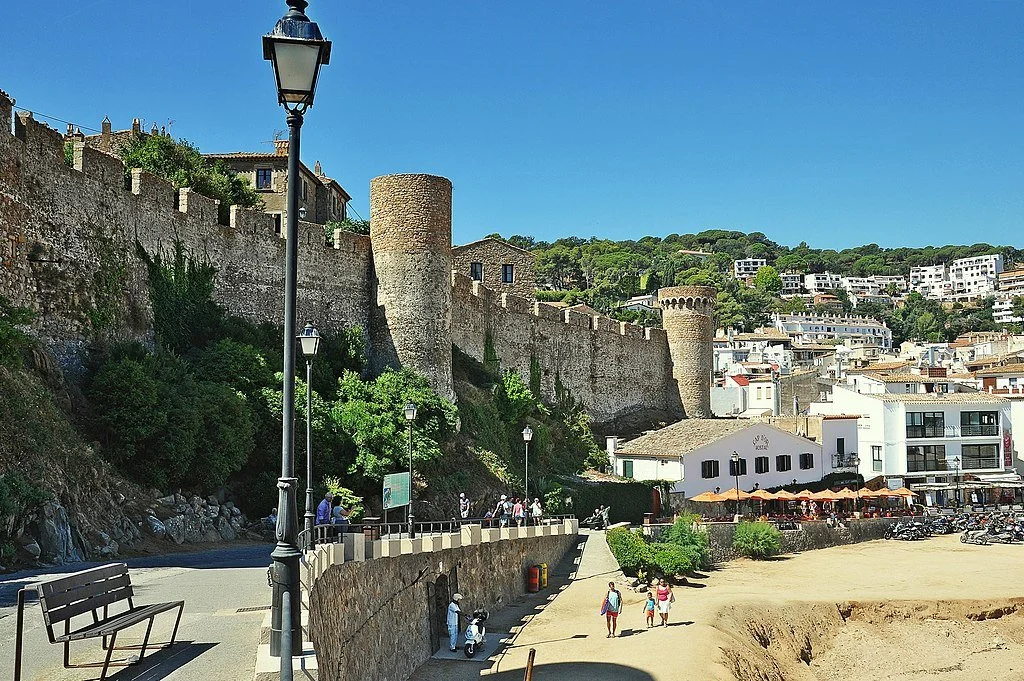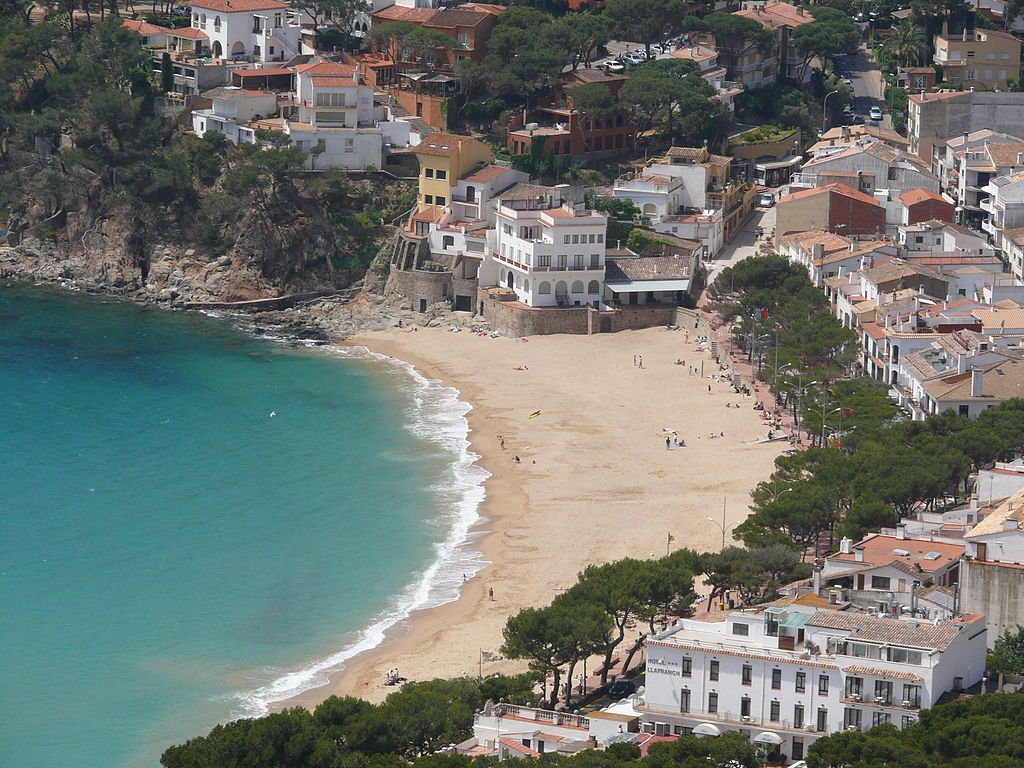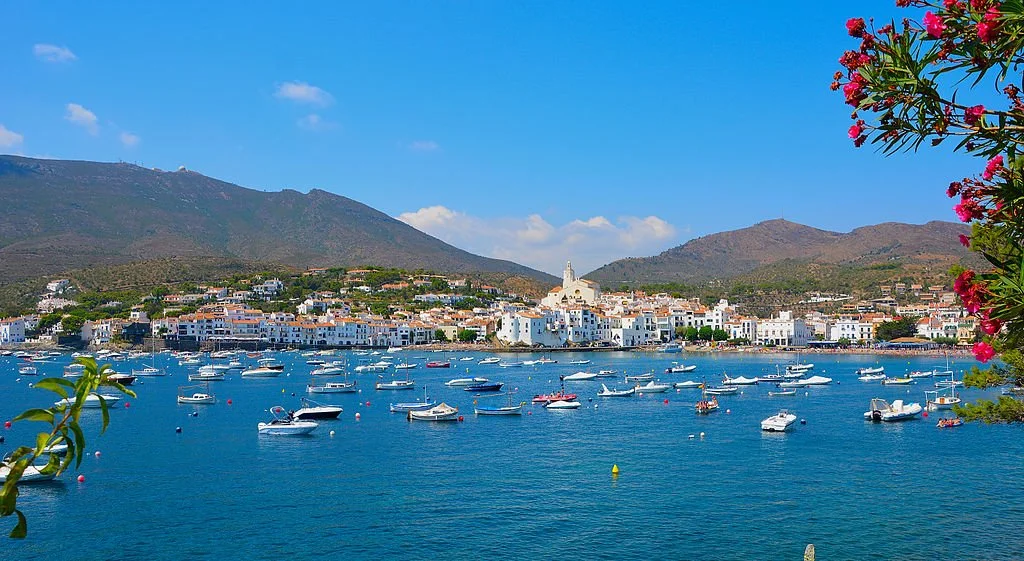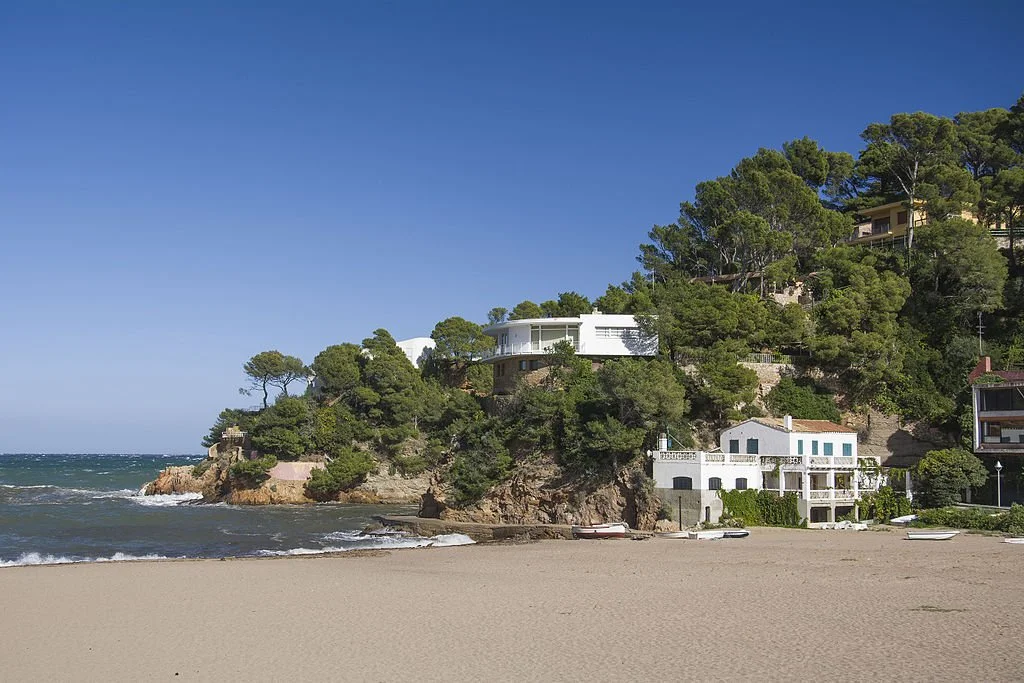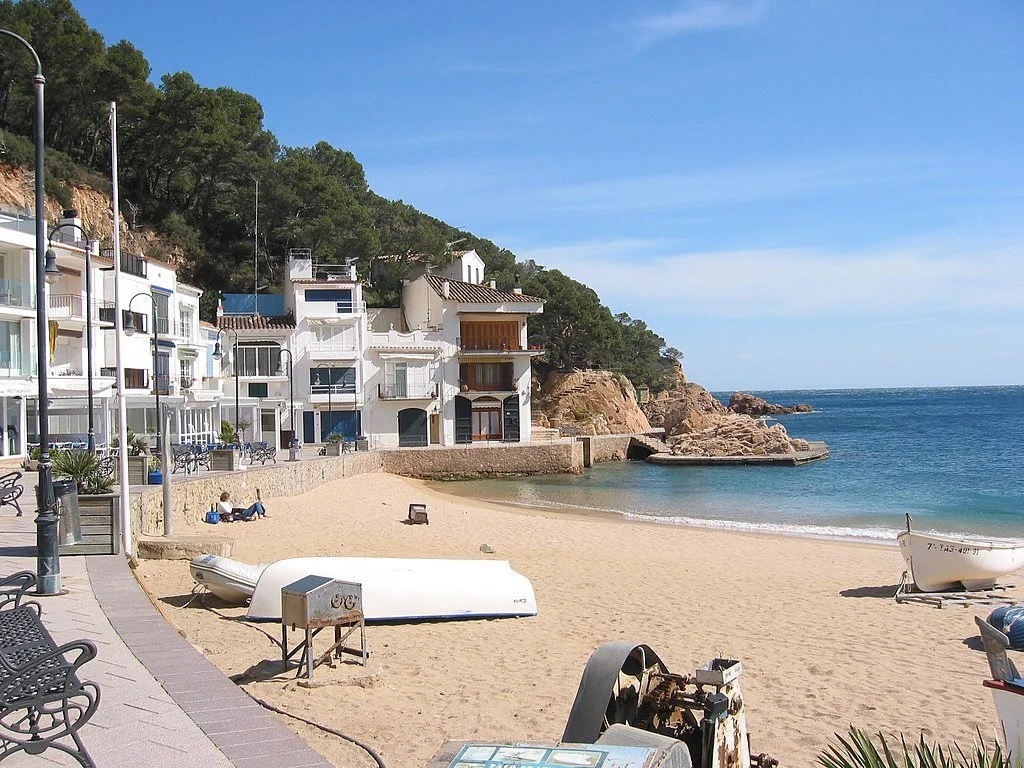Where to Stay in the Costa Brava - Best Bases
Affiliate disclosure: some of the links in this article are affiliate links. If you book using one of them, we’ll earn a small commission. All of our info is free to read and free of ads, so we appreciate it!
The Costa Brava, a sun-scorched arc of coastline in Catalunya’s northeast corner, lives up to its name - Wild Coast - with every jagged cliff and secret cove. Here, the Mediterranean crashes against ancient rock formations, while wind-twisted pines cling stubbornly to the edges of rugged promontories.
It’s a place where whitewashed fishing villages tumble down to turquoise bays and narrow dirt trails thread through scrubby forests scented with salt and rosemary.
Stretching from the town of Blanes, just an hour north of Barcelona, to the French border, this coastline is a feast for the senses. You’re winding along cliffside roads one moment, gazing at endless Mediterranean blues, and wandering through hilltop villages the next, where crumbling castles watch over the sea.
It’s popular and busy in the high season, but most of the towns here still retain that Spanish magic, without the large tourism development that other stretches of Spanish shorelines have seen. It's no wonder this coast has long called to travelers and artists alike, myself included.
For more Catalunya travel info, check out my other guides:
Table of Contents
Costa Brava planning cheatsheet
 Plan your itinerary with expert advice
Plan your itinerary with expert advice
- Book a Spain travel consultation with a local expert
 My favorite hotels in the Costa Brava
My favorite hotels in the Costa Brava
- Mas de Torrent - total luxury in Calella de Palafrugell. $300/night
- Hotel Aiguablava - an elegant classic in Begur. $175/night
- Hotel Aiguaclara - eclectic, boutique style in the heart of Begur. $120/night
- Hotel Casamar - breezy ocean views in Llafranc. $115/night
 Guided tours and activities
Guided tours and activities
- Private tours of Barcelona and Girona with Dolça
- Private Costa Brava day trip from Barcelona
- Small group full-day Costa Brava tour
- Highlights of Catalonia: Montserrat, Girona, & Costa Brava in a day
- Half-day Catamaran cruise (from Lloret de Mar)
 How to get around
How to get around
- Car rentals with DiscoverCars
- Train tickets from Renfe
- Bus routes at Sarfa and Sagales


Quick summary of my 5 recommended towns
I know it’s a cliché to say this, but the Costa Brava genuinely offers something for every type of traveler, from lively beach towns brimming with amenities to serene villages perfect for those seeking a slower pace.
Choosing where to stay along the coast depends on your priorities: you’ll find everything from the classic seaside resort towns like Lloret de Mar to quieter, more tranquil and authentic villages, nestled in quiet coves. There are family-friendly beaches and rocky inlets, places with loads of history, and towns known for their upscale dining and artistic heritage.
It’s important to note that while some towns have bus connections from Barcelona and Girona (the traditional gateways to this area), public transport across the region can be limited, so renting a car is highly recommended. Doing so will also give you the flexibility to explore the secluded coves and breathtaking coastal roads that make this region so appealing.
Essentially, this is a region with a lot of variety in its towns, but I’ve narrowed it down to five recommendations, organized geographically, starting with locations closest to Barcelona and moving outward from there.
Each is suitable for different types of travelers and offers a unique flavor of the Costa Brava, so whether you’re drawn to medieval history, pristine beaches, or bohemian hideaways, you’ll find a perfect match somewhere among them.
1. Tossa de Mar
Tossa de Mar is a medium-sized town that has a great mix of history, beaches, and a charming Mediterranean atmosphere. It’s most famous for the stunning castle that clings to one side of the bay, overlooking the pristine sandy cove and a medieval old town below.
Wander through its maze of alleys and you’ll stumble upon family-run restaurants serving fresh seafood, boutiques with handcrafted treasures, and cozy hotels with terraces that catch the sunset. Tossa de Mar also offers easy access to hidden coves and secluded beaches in both directions along scenic coastal trails.
2. Calella de Palafrugell & Llafranc
Though technically two separate villages, Calella de Palafrugell and Llafranc feel like one seamless, charming stretch of the coast.
In Calella, whitewashed houses edge the coves, and fishing boats painted in bright blues and reds bob at the shore. The air is filled with the scent of grilled fish from beachfront restaurants.
Llafranc, a short walk away along the seafront, trades Calella’s liveliness for a more refined quiet, where couples linger over wine at seafood spots overlooking the bay. Both are classic Costa Brava - intimate, beautiful, and incredibly relaxing.
3. Cadaqués
Tucked away near the French border, Cadaqués has a character all its own. Imagine the Greek islands, with white-washed streets, bougainvillea-draped balconies, and colorful seafood taverns—but with a bohemian, Catalan twist. This town was a favorite of Salvador Dalí, whose home in Port Lligat is just over the hill and open for visitors.
Cadaqués’ upscale charm feels earned, with refined restaurants tucked into historic stone buildings and boutique hotels that blend seamlessly into the rugged beauty around them.
4. Begur
For me, Begur is a must on any Costa Brava itinerary, even if not staying here. Perched on a hill inland overlooking the sea, this enchanting town has an old-world charm with its medieval castle, cobblestone streets, and Catalan stone houses. You’ll find yourself happily lost wandering the old town, popping into tapas bars, or just taking in the views.
Down the steep hill (a car is necessary), Begur’s beaches—like the secluded Sa Tuna or the vibrant Aiguablava—are some of the most beautiful on this coast.
5. Tamariu
My first experience on the Costa Brava saw me get incredible lucky - Tamariu is one of those spots that’s effortlessly family-friendly, with a vibe that feels a world away from the more bustling towns. The main beach is a picturesque, sandy crescent, and the clear, shallow waters are perfect for a long day of swimming and sunbathing.
Along the waterfront, you’ll find cozy seafood restaurants and little cafés, ideal for a laid-back lunch or evening meal with the Mediterranean in view.
Keep reading below for a more complete introduction to each town
1. Tossa de Mar
Pros: Medieval charm, reachable by public transit, family-friendly beach, lots of dining options
Cons: Crowded in peak summer months, limited parking
Looking out over Tossa de Mar. Photo: MonsieurRoi, CC BY-SA 3.0, via Wikimedia Commons
The town’s beach and castle walls. Photo: Alberto-g-rovi, CC BY-SA 4.0, via Wikimedia Commons. Cropped.
Views from the castle. Photo: Enric, CC BY-SA 4.0, via Wikimedia Commons. Cropped.
Tossa de Mar is a quintessential Costa Brava destination, combining historical intrigue, natural beauty, and vibrant seaside charm. It’s particularly famous for its iconic medieval castle, which wraps around one side of the bay, overlooking the town’s wide, sandy beach.
Within the castle walls is a small historic district, known as Vila Vella, a delightful tangle of cobbled alleys, stone walls, and historic watchtowers. Wander through here and you’ll hear the clink of glasses from tucked-away tapas bars and locals chatting over vermouth as the castle’s shadow lengthens in the afternoon light.
For beach lovers, Tossa’s crescent-shaped beach is one of the more spacious along the Costa Brava, perfect for families or anyone wanting to spread out and relax by the sea. The beach area is well-served by waterfront cafes, seafood restaurants, and ice cream shops that make for leisurely seaside dining.
For more adventurous travelers, scenic hiking trails branch out along the coast, leading to rocky hidden gems like Cala Pola and Cala Giverola, remote coves once popular for smuggling goods into Spain during the Civil War and Franco’s reign.
One of Tossa’s biggest advantages is its accessibility. With regular bus connections to Barcelona and Girona, it’s an ideal choice for travelers who prefer not to rent a car. During summer, however, its popularity means larger crowds and limited parking, so plan accordingly if visiting during peak season.
Where to stay
Boutique Hotel Casa Granados - A luxurious retreat in a restored 19th-century mansion, complete with lush gardens and a pool. $175–300 USD
Hotel Diana - A boutique, family-owned hotel housed in a Modernist building right on the beach, offering elegant decor and stunning sea views. $160-250 USD
Golden Mar Menuda - Located on Mar Menuda Beach, this mid-range hotel is perfect for families, featuring a pool and direct beach access. $130–200 USD
Hotel Delfín - A four-star hotel just steps from the beach, boasting a rooftop pool with panoramic views of the castle. $120-200 USD
Hostal del Mar - A budget-friendly, family-run guesthouse in the old town, known for its friendly service and cozy rooms. $80–130 USD
2. Calella de Palafrugell & Llafranc
Pros: Stunning scenery, excellent dining, access to beautiful coves right in both villages
Cons: Limited nightlife, higher accommodation costs compared to other towns
Calella de Palafrugell. Photo: Jorge Franganillo, CC BY 2.0, via Wikimedia Commons
Calella de Palafrugell seen from just outside the town. Photo: Marine Citron Vert, CC BY-SA 4.0, via Wikimedia Commons
Llafranc’s beach seen from the Sant Sebastia lighthouse. Photo: DagafeSQV, CC BY-SA 3.0, via Wikimedia Commons
Llafranc, seen from the promontory separating it from Calella de Palafrugell. Photo: Chris j wood, CC BY-SA 4.0, via Wikimedia Commons
Though technically two separate villages, Calella de Palafrugell and Llafranc feel like one seamless, charming stretch of the coast. I first discovered these twin villages while hiking the Cami de Ronda, the historic walking trail that links all towns along the coast.
Coming around the corner, Calella de Palafrugell was a sight to behold, a cluster of whitewashed houses with terracotta roofs spilling down gently to meet the water, an impossibly clear shade of blue green (I later learned that it’s one of the most photographed towns on the Costa Brava). Along the promenade and in the narrow streets of the town are plenty of cafés and good restaurants, and it was busy even before the high season had arrived.
Llafranc, just around the bend, has a quieter, slightly more upscale feel. Its smaller beach and upscale vibe attract discerning travelers seeking a peaceful escape. Here, you’ll find fewer crowds and some of the region’s best fine-dining seafood restaurants overlooking the water, perfect for an elegant meal overlooking the water.
Both Calella and Llafranc attract a mix of families, couples, and anyone seeking relaxation and beauty without a hectic tourist scene. It’s worth noting that both villages are among the pricier options along the Costa Brava, but the idyllic scenery and ambiance make it worth the splurge.
Where to stay
El Far Hotel Restaurant - A boutique luxury hotel in a historic lighthouse in Llafranc, with panoramic sea views and elegant dining. $250-350 USD
Sant Roc Hotel - Perched on a cliff with stunning views and an excellent on-site Mediterranean restaurant. $140-230 USD
Hotel Llafranch - A stylish, beachfront hotel with a seafood restaurant specializing in fresh, local dishes. $140–220 USD
Hotel Alga - A mid-range family-friendly option with a large garden, pool, and easy beach access. $120–200 USD
Hotel La Torre - A charming, family-run hotel located between the two villages, known for its terrace bar overlooking the sea. $100–180 USD
3. Cadaqués
Pros: Lots of artistic heritage, bohemian charm and a tranquil vibe, great access to the Cap de Creus Natural Park
Cons: Only accessed via a narrow, somewhat intimidating road, rather high prices
Cadaqués. Photo: Anthiro 57, CC BY-SA 3.0 ES, via Wikimedia Commons. Cropped from original
Cadaqués at sunrise. Photo: Rodolphe31, CC BY-SA 3.0, via Wikimedia Commons. Cropped from original
The town seen from es Poal beach. Photo: Castellbo, CC BY-SA 4.0, via Wikimedia Commons. Cropped.
Nestled near the French border, Cadaqués is unlike any other town on the Costa Brava. Known for its whitewashed buildings and rugged coastline, this postcard-perfect town has long been a magnet for the artsy crowd—thanks to its most famous resident, Salvador Dalí. The surrealist master called Cadaqués home, and his influence is palpable in its local galleries and creative spirit.
Dalí’s former home in nearby Port Lligat (a short walk from Cadaqués) is now a museum, and its eccentric design reflects the surrealist’s creative spirit.
The first time I visited Cadaqués, I was struck by how quiet it felt—a welcome surprise after spending a few nights in busier part of the Costa Brava, especially when Cadaqués crops up all the time in travel articles online. The road into town is narrow and winding, which likely deters some visitors, adding to the town’s secluded appeal.
Dining in Cadaqués spans from traditional Catalan fare with a seaside view to inventive, high-end cuisine nestled in rustic, stone-walled restaurants. Accommodation here tends to be boutique-style and on the pricier side, catering to travelers who appreciate charm and exclusivity.
That boho and artsy vibe is contrasted by the natural beauty of the surrounding landscapes. Cadaqués sits in the wild Cap de Creus Natural Park, offering some of the Costa Brava’s most rugged landscapes and quiet hiking trails, some accessible from town.
Where to stay
Hotel Boutique Horta d’en Rahola - A romantic hotel in a historic building with a lovely garden. $180–250
Hotel Playa Sol - A beachfront hotel with lush Mediterranean gardens, a pool, and a laidback ambiance. $150–250 USD
Hotel Tramuntana - A minimalist boutique hotel in the heart of the village. $160–220 USD
Hotel Llane Petit - A cozy hotel on a quiet beach, ideal for couples seeking privacy. $130–200 USD
Hostal Marina - A budget-friendly option in the town center with simple but comfortable rooms. $90–130 USD


4. Begur
Pros: Historic charm and a lively culinary scene, nice boutique hotels and upscale atmosphere
Cons: Not directly on the coast so getting to beaches requires a short drive
Begur. Photo: Albert Torelló, CC BY-SA 2.0, via Wikimedia Commons
Aiguablava beach, near Begur. Photo: Miquel Àngel Patiño, CC BY-SA 4.0, via Wikimedia Commons. Cropped.
Sa Riera beach, near Begur. Photo: Armando Gonzalez Alameda, CC BY-SA 4.0, via Wikimedia Commons. Cropped.
Begur is a mesmerizing blend of historic charm and coastal allure, perched on a hill just a short distance from some of the Costa Brava’s most beautiful coves. Though slightly inland, this village more than compensates for the lack of immediate beach access with its undeniable atmosphere and authenticity.
The town center is a delightful maze of cobbled streets lined with historic buildings, elegant old townhouses, and a few watchtowers, built to keep an eye out for raiding pirates who pillaged the coastline below. Towering above it all is Begur’s 11th-century castle, a landmark that offers sweeping views of the town, the sparkling sea, and the surrounding pine-covered hillsides dotted with charming villas.
These days, Begur draws a cosmopolitan crowd, lured by its excellent culinary scene, boutique hotels, and a laid-back allure that’s captures you instantly. Summer here is a lively affair, with bustling open-air markets, live music filling the plaza, and a mix of boutiques, art galleries, and cozy tapas bars that give the town a stylish edge. As the sun sets, Begur’s plazas fill with the clink of glasses, the strum of guitars, and the warm buzz of voices.
While not on the coast itself, it’s a short drive to some of the Costa Brava’s most beautiful coves, like Aiguablava and Sa Tuna. These beaches are small and secluded, perfect for visitors who appreciate natural beauty and tranquility. However, without a car, accessing these coves can be challenging. Sa Riera, another nearby beach, is larger and offers more amenities, making it a good option for families who want easy access to a beach with facilities.
Where to stay
Hotel Sa Calma - Boutique hotel in the middle of Begur with elegant decor, a rooftop terrace, and a good spa. $180–270 USD
Hotel Aiguablava - Cliffside hotel with direct beach access a bit below the town center. It also has an outdoor pool and lush terrace. $160–250 USD
Hotel Convent de Begur - A tranquil little hotel set in a restored convent with a lovely garden and pool. $130–210 USD
Hotel Rosa - Charming family-run hotel in central Begur with a good on-site restaurant and cozy rooms. $120–180 USD
Hostal Sa Rascassa - Good budget-friendly guesthouse in a secluded, beachfront location. $90–130 USD
5. Tamariu
Pros: Family-friendly beach and calm waters, scenic coastal hiking trails, peaceful, local atmosphere
Cons: Limited nightlife and amenities, requires a car for access
Tamariu. Photo: Chris j wood, CC BY-SA 4.0, via Wikimedia Commons
The town’s beach and waterfront. Photo: PaddyBriggs at English Wikipedia, Public domain, via Wikimedia Commons
Tamariu is the kind of place that feels like a well-kept secret. Tucked into a quiet, forested cove, this former fishing village trades the chaos of big resorts and bustling boardwalks for a simple, unspoiled charm. Whitewashed houses hug the curved shoreline, where a sandy crescent of beach meets clear, shallow waters. The pace here is unhurried, the mood relaxed, the crowds non-existent.
My first trip to the Costa Brava was to Tamariu, a place that set the bar impossibly high. Though small, Tamariu has everything you need for an idyllic day by the sea—lazy hours on the sand, fresh seafood by the water, and the sound of waves rolling in to keep time. There’s only a handful of hotels here as well, with the campground out the back of town hosting the biggest crowds.
Tamariu isn’t the easiest place to reach, but that’s part of its magic. Buses don’t come here, so you’ll need a car, which also conveniently frees you up to explore the coastal coves in either direction. Its quiet nature means limited nightlife and fewer amenities compared to larger towns.
For families, couples, or anyone looking to escape the bustle of bigger towns, Tamariu offers a slice of the Costa Brava that feels timeless.
Where to stay
Hotel Hostalillo - Up on the hillside and with a terrace offering stunning views of the bay, this is the perfect option for couples. $130–210 USD
Hotel Tamariu - A family-run hotel right on the beach with a relaxerd atmosphere and good seafood restaurant. $120–200 USD
Hostal Es Niu - With just a handful of cozy rooms, each with a private balcony, this family-run guesthouse is quite inviting. $90–140 USD


More Spain travel info
For even more advice on planning your trip to the Costa Brava and Spain, have a look at some of our other guides and itineraries!

Connect with Dolça







